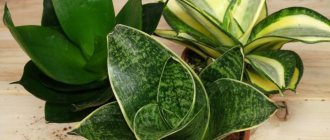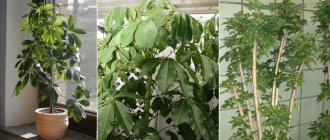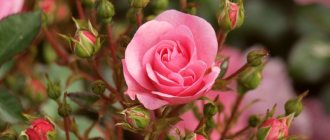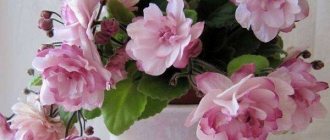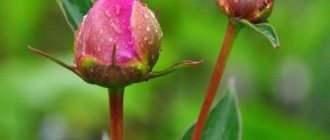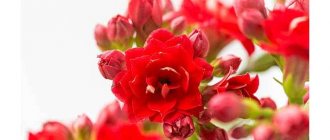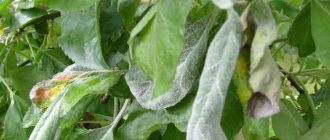The Sansevieria genus includes 60 species of perennial, stemless succulents and foliage plants, distributed in areas of Africa, Madagascar, India, South Florida and Indonesia.
Succulents with hard and tough foliage grow in hot, arid desert climates, while deciduous varieties come from tropical and subtropical regions.
The genus name is given in honor of the Italian scientist and inventor Raimondo di Sangro (1710-1771), Prince of Sanseviero, who brought the succulent from Africa to Naples in the 18th century. Since then, the flower has gained immense popularity in Europe.
Sansevieria is an ideal indoor flower that combines decorativeness and absolute unpretentiousness in home care.
Description
Sansevieria moonshine (sansevieria) has the Latin name Moonshine and belongs to the Agave family. Moonshine – translated as “silver moon” , this description corresponds to the color of the leaves of this flower. Among gardeners, the plant is also called “pike tail” (a collective name for all types of sansevieria) or “snake skin”. You can learn more about Sansevieria species here.
Moonshine is a perennial, evergreen plant. Its leaves are dense, erect, and pale green in color. A distinctive feature is a bluish-silver tint. The stem is missing. The leaves appear immediately from the rosette, curl at its base and tend upward. Their width reaches 5-6 cm, and their height is about 30 cm. The flowers are white, collected in miniature panicles. The diameter of the rosette rarely exceeds 12 cm, and the height is 35 cm.
Reference! The habitat of wild Sansevieria Moonshine is the subtropical zones of Africa, India and Madagascar.
Lighting
The plant develops equally well both on an open windowsill - in bright sun, and under artificial lighting - in partial shade.
But, by the way, lack of light is the only thing that can ruin variegated varieties. Constant artificial light does not give it such a rich green color. This means that the process of photosynthesis is lame, and therefore at least a rare sun will not interfere with it.
As an example: Sansevieria almost died in 2-3 months in the vestibule of the entrance, where my mother took it out. There were no windows at all, only fluorescent lamps.
In summer and spring it will be great if we take the plant out into the fresh air. Just preferably under some kind of canopy so that rains and drafts do not destroy it.
Photo
Below you can see a photo of the plant:
Reproduction
At home, this Sansevieria variety is propagated by root division and cuttings. It should be taken into account that the variegated forms - hunny golden and hunny silver - will lose their color when propagated by cuttings . To preserve it, these varieties are propagated exclusively by dividing the rhizomes.
- Propagation by dividing rhizomes
During spring transplantation, the extracted rhizome is cut into pieces with a sharp instrument. Each segment must have at least one growth bud. The sections are treated with fungicide or crushed charcoal and parts of the rhizome are planted in separate containers of appropriate sizes.
- Propagation by cuttings.
For such propagation, you need to select a mature leaf, cut it off, lay it with the bottom surface up and divide it with a sharp knife in the transverse direction into pieces from five to seven centimeters long. These leaf cuttings are withered for some time, then planted in moistened sand, buried a third of the length, and covered with plastic film. Moderate watering is carried out through a tray, and the greenhouse is regularly ventilated. Rooting, as a rule, occurs after one and a half to two months. Then the cuttings are grown by planting them in a standard soil mixture for sansevieria.
How to care at home?
Sansevieria Moonshine is unpretentious and does not require special attention or special conditions for growing. In order for the leaves to be dense and not lose their characteristic color, you must adhere to the following care rules.
Temperature
Sansevieria is unpretentious to temperature increases; it grows well in the range from +18 to + 35°C. But when it drops below +15 °C, the plant will first lose its characteristic color, and then may even die.
Watering
The main condition is regularity, without excessive drying out or waterlogging of the soil.
During the winter months, the frequency of watering is reduced as the temperature drops , down to an interval of 2-3 weeks. In summer, the frequency reaches 1-2 times a week.
The water should be settled and at room temperature. In all seasons, the foliage must be wiped with a damp sponge at least once a week, avoiding moisture getting into the outlet.
Light mode
Sansevieria prefers a well-lit place , without direct sunlight. Summer afternoon sun can leave burns on its leaves.
Attention! With insufficient lighting, plants slow down and the leaves become dark green without a bluish tint.
Priming
For planting, universal soil is suitable, additionally enriched with loosening components:
- perlite;
- pebbles;
- fine expanded clay.
To make your own soil you will need:
- leaf soil - 1 part;
- sand – 1 part;
- turf soil - 2 parts.
Pot
Sansevieria is very elongated, so for stability it will need a low but wide pot. Its diameter should be approximately twice the height. The powerful roots of Sansevieria can easily deform or even break a thin plastic pot. Preference should be given to thick-walled ceramic options.
Transfer
Due to its slow growth, the plant does not require frequent replanting . A sign of its need is the appearance of roots from the drainage holes at the bottom of the pot.
The optimal time for the procedure is late spring-early summer.
Step-by-step instructions for transplanting Sansevieria:
- Pour at least 1.5-2 cm of drainage into the bottom of the new pot. Its role can be small pebbles or expanded clay.
- Pour soil on top, the thickness of the layer depends on the height of the pot (but not less than 2 cm).
- Place the flower and distribute the root system throughout the pot.
- Fill with soil to the edge of the pot. Press lightly with your hand and pour generously.
Fertilizing
Mineral fertilizers for indoor plants or succulents are suitable for Sansevieria Moonshine . It is more convenient to use fertilizer in liquid form. The application period is from March to September. Before use, the fertilizer must be diluted twice as much as indicated in the instructions. Fertilize no more than once every two weeks.
Trimming
To perform pruning, you only need well-sharpened scissors. Execution algorithm:
- Remove all yellowed, rotted or dried leaves.
- Trim the dried ends, not retreating more than 1 cm from the edge of the sheet.
- Treat the cuts with crushed coal.
Important! Pruning is performed only to remove dried foliage; the plant does not need shaping.
Wintering
In anticipation of the winter months, it is necessary to gradually reduce watering to once every 2-3 weeks. The temperature should not drop below +15 °C; prolonged exposure to open windows or vents should be avoided. To preserve the color of Sansevieria Moonshine, additional lighting is required during the winter months.
Features of reproduction
You can get a young plant in two ways:
- By dividing the rhizome .
In spring, remove the mother plant from the pot and divide its rhizome into several parts. Each of them must have at least one growth point. Plant in new pots, place in a warm place and water moderately. Rooting time is 1-1.5 months. - Side shoots . During transplantation, separate the already formed young shoots and plant them in new containers. It will also take about a month for complete rooting.
Important! When using the leaf propagation method, loss of the decorative qualities of the plant, in particular the color of the shoots, is possible. Therefore, preference should be given to dividing the rhizome and side shoots.
Popular types:
Sansevieria 'Almond Silver'
If you are looking for a plant that is persistent, unpretentious, but capable of intriguing and standing out, Sansevieria “Silver Almond” is just for you! The plant has strong, hard, branched leaves up to 40-45 cm in length. When we look at a plant in profile, its appearance may evoke associations with a fan. The leaf blades are massive, very fleshy and hard. Unusual shaped sockets. The edges of the leaves are distinguished by a delicate notch and silvery color. The surface of the leaf blades is muted, gray-green or olive in color. “Almond Silver” is a rare, but extremely interesting and amazing variety of Sansevieria.
Sansevieria 'Amazon Green' - spiral (Sansevieria 'Amazon Green')
An interesting succulent in a minimalist style. Its long, narrow leaves taper upward and end at the top with long, sharp tips. The edges of the leaf blades are decorated with a delicate, invisible light green border. This elegant accessory beautifully emphasizes his unique, familiar look. Rigid, symmetrical rosettes form a majestic, regular plume of whorled leaves that flow smoothly outward.
The undoubted advantage of this plant is its dense foliage of an elegant, rich green color. Sansevieria "Amazon Green" will perfectly complement the collection, and will also look great in all interiors and will be a wonderful contrast to more muted colors.
Sansevieria 'Black Gold'
Interesting succulent with amazing foliage. At home, it can reach 100–150 cm in height and 25–50 cm in width. Exotic dimensions make the plant an excellent choice when decorating modern interiors. Sansevieria produces fleshy, sword-shaped, pointed leaves with sharp edges. The dark green color of the slightly wavy leaf is emphasized by lush yellow edges. “Black Gold” is a rare variety for sale, and therefore very valuable and in demand. The intensity of leaf color and the resulting contrasts largely depend on growing conditions.
Sansevieria 'Comet Pixel'
An interesting variety with a silver-green color and a rosette, but slightly disheveled. The leaves are medium wide, groove-shaped, and decorated with an interesting pattern. Despite the differences in the design, vertical thin green lines are clearly visible on all sheets. The youngest leaves are lighter, steel green with clearly defined vertical lines. Uneven dark green stripes gently penetrate here and there. As it matures, more and more dark green color appears, and dark green transverse veins are already visible on older leaves.
Sansevieria 'Greenline'
Produces an erect, tall clump of narrow, long, sword-shaped leaves growing side by side. The surface of the leaves is decorated with magnificent dark green transverse variegated stripes. Sansevieria Greenline is an excellent choice for those looking for plants that are unpretentious, resilient, yet attractive and elegant. It looks great in both modern and classic interiors, adding a touch of exoticism.
Sansevieria bacularis Mikado (Sansevieria 'Fernwood Mikado')
An excellent variety that grows to a maximum height of about 70 cm. It has raised cylindrical, not too thick pointed leaves. The surface of the leaf blade is dark green, decorated with light green transverse stripes. The leaves grow straight from the ground, one next to the other, forming beautiful prickly clumps. This variety is valued for its beautiful color, interesting appearance and low requirements.
Sansevieria 'Queen Marble'
A distinctive succulent with interesting colors. The rosettes of leaves have a rigid shape, reminiscent of the foliage of a pineapple fruit. Its leaves are massive, fleshy and densely spaced. The alternation of dark and light green perpendicular stripes gives them an original color. The color scheme changes slightly with the phase of their development. Young leaves growing from the center have a bright green color, and as they mature, their shade becomes highly saturated. Thus, the transverse stripes turn into dark green irregular stripes and contrast beautifully with the light green of the rest of the leaf blades. Additionally, they emphasize the bright color of the youngest leaves that are just blooming. 'Queen Marble' has dense foliage that looks great on a shelf or windowsill.
Sansevieria 'Silver Nymph'
An interesting variety that, in combination with other sansevieria, has an extremely intriguing appearance. "Silver Nymph" has narrow, long, hard, pointed leaves. The silvery, light green surface of the leaf blades is decorated with transversely located abrasions of a dark green hue. The plant forms spectacular rosettes with an erect habit. Its leaves grow from a single shoot and spread widely at the top. This way they create an interesting, slightly ruffled shape. Sansevieria “Silver Nymph” is an elegant and original interior decoration, the great advantage of which is its low growing requirements and high stability.
Sansevieria 'Star Iguana'
An excellent low variety with a calm color, without clear stripes or patterns on the leaves. It is characterized by a clear predominance of green color on the leaf blades and a slightly yellowish, finely porous middle of the leaf. Despite the clear predominance of green, the presence of lighter and more subtle color changes creates a beautiful and light shading on the leaf blade - lighter in the center and darker at the edges. The wide leaves taper upward, pointed, and form a rosette. The edges of the leaves are decorated with a thin, lighter border, ideally emphasizing the wide shape of the leaf. This is an excellent offering for Sansevieria collectors who appreciate the variety of details that distinguish the Star Iguana from other varieties of the species.
Sansevieria 'Tiara Grand Gazelle'
A very interesting variety, recommended for fans of Sansevieria and those who want to decorate the interior with a spectacular and at the same time unpretentious plant. It attracts attention with its original fan-shaped shape. The leaves lie tightly to the ground, they grow alternately - now to the right, now to the left, and diverge at the same distance from each other. In addition to the original and orderly shape of the whole plant, the green, long, narrow, grooved and pointed leaves are undoubtedly a decoration. Despite the muted colors, darker vertical lines and striations are clearly visible on the leaves.
Sansevieria 'Tough Lady'
A charming succulent with an interesting green color. Its leaves grow in layers, forming a beautiful harmonious rosette with a vertical, majestic silhouette. The green leaf blades are varied with darker green spots directed perpendicular to the edge. Young pointed leaves grow from the center and fly up. As they grow, they gradually take on a deeper shade of green. As a result, the rosette, seen from the side, displays the fullness of its charm, showing an interweaving of dark green and silvery shades of green.
Sansevieria aubrytiana 'Dragon'
The most striking decoration of the “Dragon” is the fantastic sword-shaped leaves with a characteristic spotted pattern. Sansevieria "Dragon" has rather wide and pointed leaves that smoothly curl in a spiral. Although the leaves grow close together and are raised upward, the plant takes on a somewhat chaotic appearance as some of the leaves bend slightly in different directions.
However, the most attractive is the mottled bright silver-green pattern across the entire surface of the leaf blade. The spots are mostly irregular, but densely punctate, contrasting very clearly with the dark green leaves. Sansevieria "Dragon" is an excellent choice for those who are looking for unpretentious, persistent, but at the same time attractive and elegant plants. Looks great in both modern and classic interiors.
Guinea Sansevieria 'Laurentii' (Sansevieria 'Laurentii')
A very interesting leaf succulent. It tolerates harsh living conditions very well, is undemanding and easy to grow. Planted in a beautiful pot, it will look great and be an elegant decoration for both modern minimalist interiors and traditional apartments. The species originates from equatorial Africa, hence its exotic beauty, low requirements and high resistance. It grows to approximately 100-150 cm in height and produces thick, stiff, raised, sword-shaped leaves that fit tightly together.
The dark green surface of the leaf blade with a golden border is additionally decorated with irregular transverse gray-green stripes. The plant blooms in early summer. Then small white-cream flowers appear, located on a long stem. They are not very decorative, but they exude a pleasant, strong, sweetish aroma.
Sansevieria 'Black Superba' (Sansevieria Black Superba)
An elegant variety characterized by beautiful patterned foliage. Sansevieria Black Superba is a less common, close relative of the popular Sansevieria Futura Superba. However, its leaves are darker, due to which the contrast of the green surface in combination with the yellow border is more emphasized. The visual effect is further enhanced by irregular striped abrasions in a creamy green color. Its long, broad, gently curled, stiff, sword-shaped leaves with sharp tips form attractive, compact, upright tufts. It looks great in both modern and classic interiors, adding an exotic atmosphere to them.
Sansevieria trifasciata 'Golden Flame'
A phenomenal, rare and hard-to-find variety, captivating with its rich contrasting color. It has hard, rather wide leaves with a beautiful glossy surface. The center of the rosette is yellow and the outer leaves are dark green with yellow accents. Sansevieria 'Golden Flame' produces wonderful two-colored clumps reaching approximately 45cm in height. Young leaves are bright yellow, while older leaves are dark green.
Interesting, expressive colors make the Golden Flame variety an original, modern interior decoration. The plant looks very elegant, is also easy to grow and is extremely resistant to lack of water and light. This is a valuable collectible variety that is difficult to obtain and is found in limited quantities.
Sansevieria metallica 'Silver Siam'
A unique and rare variety of Sansevieria with a beautiful unusual color. Sansevieria metallica 'Silver Siam' grows to approximately 60cm in height. Its decoration is long, hard, sword-shaped leaves. The surface of the leaf blade is green-gray, additionally decorated with vertical irregular blurry stripes of creamy white color. Decorative, erect leaves grow close together to form attractive compact clumps.
During flowering, the plant produces beautiful tiny white flowers located on a straight, thick stem. In addition to the unusual coloring, the big advantage of this unusual variety is its low cultivation requirement and high resistance to lack of water and light.
Guinea Sansevieria HAHNII 'Golden Blue' (Sansevieria HAHNII 'Golden Blue')
Sister of the popular Golden Hahnii variety, which is characterized by a clear predominance of blue on the leaf blades and a less creamy edge. Like her cousin, she has a small target size and a slow growth rate. The rounded leaves taper upward and end with sharp tips. The edges are decorated with an irregular gold border, which perfectly emphasizes the broad shape of the leaves, and also contrasts with the blue and green color of the central part. The leaf blade has a pastel blue color, which is varied by irregular silver stripes located perpendicular to the edge.
Sansevieria fisherii
An exceptional species, surprisingly variable as it grows. The juvenile form has short, stiff leaves with recurved grooves and arched leaves. They fold out to the sides to form a compact socket. Older plants have taller and more tightly curled leaves. Mature plants grow more upright and lose their rosette shape.
In addition to its interesting and varied growth habit, Sansevieria fischeri impresses with its attractive leaf colors, ranging from gray to brown-green with lighter transverse striped patterns. The edges of the leaves are indicated by a brown border. It grows naturally in Kenya, Tanzania, Ethiopia and Somalia in sunny locations with well-drained soil.
Sansevieria cylindrica 'Tiara Emerald'
A beautiful potted plant with a characteristic regular fan-shaped shape. The plant has no distinct stem and its thick, cylindrical and blunt leaves lie tightly to the ground. The undoubted decorative value of Sansevieria 'Tiara Emerald', in addition to the characteristic fan-shaped and cylindrical shape of the leaves, is also the amazing dark green, even emerald color of the leaves. There are no clear patterns or spots on them, only subtle lighter spots appear here and there.
Palatally diverging rosettes are rigidly embedded in the substrate, grow slowly and do not lose their typical fan shape. Over time, children's sockets appear next to the main outlet.
Sansevieria cylindrica 'Lady Charm'
A new interesting variety of sacevieria, cylindrical in shape with clear, thick strokes. Its vertically arranged leaves are thick and round in cross section. The olive green color is interspersed with darker patterns running across the axis of the leaf blades. Numerous green stripes are densely spaced, and their lines are irregular and wavy. It seems that they were made with neat brush strokes.
The pointed leaves grow rigidly upward, turning slightly to the sides at the apical part. They end up creating lush, dense, lumpy shapes. 'Lady Charm' is unlikely to reach its large target size and will grow slowly, like most trumpet sansevierias. An attractive variety that will complement the design of modern and classic interiors. Another interesting proposal to complement the collection for sansevieria collectors.
Sanseveria 'Boncel' (Sansevieria cylindrica 'Boncel')
Sanseveria 'Boncel' produces a very distinctive regular fan shape. Thick, cylindrical leaves are obtuse. They do not have petioles or other parts typical of popular houseplants. The plant also does not have a distinct stem. Its silvery-green leaves lie tightly to the ground, forming a rigid rosette.
The ornament is not only a characteristic shape, but also transverse green whorls distributed along the entire length of the cylindrical leaves and a delicate shine on their hard skin. Palm-shaped rosettes are firmly embedded in the substrate, growing slowly by elongation and expansion, but without losing the typical fan shape. Over time, children's sockets appear in parallel at the main outlet.
Sansevieria 'Boncel' is a very elegant and original houseplant with low requirements. It combines an attractive, interesting shape with high resistance to lack of water and lack of light.
Sansevieria trifasciata 'Fire'
The first association that comes to mind when looking at Sanseveria 'Fire' is a fiery flame. Thanks to the shape and pattern of the leaves, it is extremely impressive, and in a properly selected pot it will certainly become an original and spirited interior decoration. It owes its vibrant and fiery beauty to its extremely interesting leaves.
The extremely broad, leathery and shiny leaves are dark green in the center and their edges are marked with a broad yellow-gold border. In some places, green vertical lingual stripes appear on the yellow edge, resembling thin flames. Additionally, the leaves of Sansevieria fiery are neatly twisted and end sharply, which, together with the pattern on the leaf, creates an association with a burning fire. It grows tall and quite compact.
Diseases and pests
The main pests of this variety are:
- Spider mite . The leaves turn yellow and white spots appear on them. For prevention, wiping with a damp sponge is used; for treatment, the insectoacaricide Actellik is used.
- Thrips . The leaf blade becomes grayish-brown, and eggs laid by the pest are visible on the underside. Insecticides are used for treatment.
- Mealybug . The foliage becomes distorted, turns yellow and dies. If the pest colony is small, it can be removed by wiping the leaves with a damp cloth. In case of severe damage, karbofos is used.
The most common diseases and care errors are:
- Brown spots and dried areas are symptoms of anthracnose. The disease develops due to waterlogging and is treated with a fungicide solution.
- Yellowness and softening of the leaves at the base is another sign of waterlogging. All affected shoots must be removed and the plant transplanted into fresh soil.
- Uniformly withered leaves and their death may indicate an excessive drop in temperature and dry soil. Sansevieria must be moved to a warm place and all damaged areas removed.
Signals of trouble
The leaves turn yellow - a sign of waterlogging, stagnation of water in the leaf rosette. A replantation is required, removing damaged leaves and drying the roots.
Sansevieria does not grow - as a rule, this is a consequence of too low temperatures.
Leaves with whitish spots are signs of sunburn.
Brown spots on the leaves are a sign of lack of light and excess moisture.
Leaf rotting in dry soil - the plant is kept in the cold.
Red-brown spots with a yellow border are a fungal disease.
Similar flowers
Other representatives of this genus are most similar to Sansevieria Moonshine:
- Cylindrical.
- Futura.
- Bacularis.
- Black Coral.
- Laurenti.
Did you know that sansevieria purify indoor air from toxic substances such as formaldehyde and nitric oxide? To successfully grow this flower, we recommend reading our articles about three-strip, Velvet touch and Hanny.
Sansevieria Moonshine is a beautiful and unpretentious houseplant that is suitable not only for beginner gardeners, but will also add to the collection of experienced indoor plant lovers.
Story
Sansevieria hanni is native to tropical Africa.
It was introduced to America during the Spanish colonization period between 1765 and 1820. In 1891, C. R. Dodge wrote a report on fiber research for the US Department of Agriculture, and there he reported that the species Sansevieria hanni could grow in several places in southern Florida. Between 1910 and 1940, several attempts to cultivate Sansevieria for fiber production were made in Mexico, Cuba, Puerto Rico, the Bahamas and the British West Indies, where the plant became quite widespread. In 1918 N.L. Britton said the species is "common in gardens" in Bermuda. In Florida during the 1920s, Sansevieria was commercialized as a potted plant and later exported to Europe, Central and South America, and the Caribbean. In Australia, Sansevieria is classified as a potential weed, but here it is widely used as an ornamental plant.
This aggressive invader quickly colonizes the areas where it grows. The "Hanny" species is very common in nurseries around the world and therefore has a high likelihood of colonizing new habitats.
Pike tail bloom
The ability of the pike tail to flower depends on compliance with the recommended care rules. The buds are not particularly beautiful, but they fill the room with a perfumery aroma with sweetish notes.
The corollas are collected in a brush on an elongated peduncle and bloom in the evenings . Flowers with narrow petals and long stamens are colored in the same color scheme as the leaves - beige-green.
It will be possible to observe flowering only after the plant has rested in a cool place and is relatively dry.
The flower perceives such conditions as extreme and soon begins to produce flowers to form seeds. Just a month is enough for a flower bud to form, after which the previous watering is resumed in the warmth.
Transfer
A plant purchased at a flower shop is placed in a shaded place for 2 weeks to adapt. Then the sansevieria is transplanted as follows:
- Take a pot slightly larger in volume than the previous one.
- Pour drainage into the bottom and fill one third with soil.
- Carefully shake the bush out of the old container, and trim the dried roots if necessary.
- Place a flower in the middle of the pot and cover it up to the root neck with soil.
- The substrate is lightly compacted and watered.
Excess water is poured out of the pan. Sansevieria is placed in a shaded room for 3-5 days, then placed in a permanent place.
